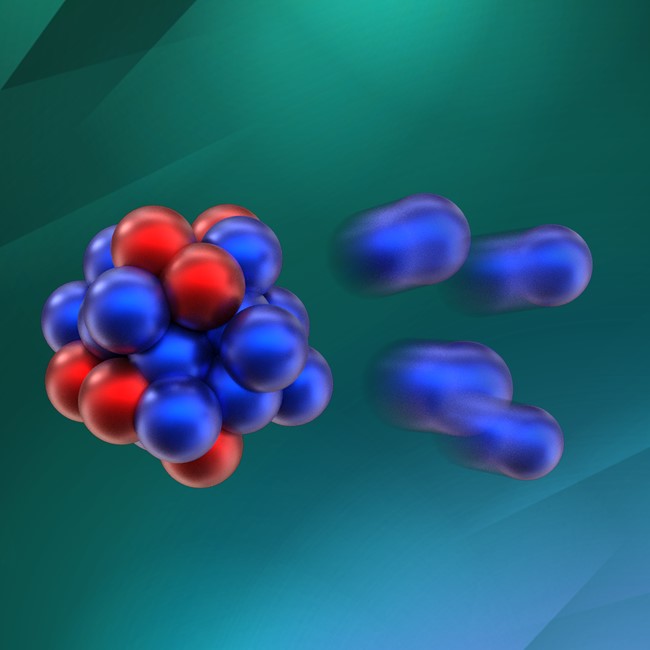The Science
The nuclei at the center of the oxygen that we breathe each consist of eight protons and eight neutrons. These are “magic” numbers of nucleons—numbers of protons and neutrons that make a nucleus more strongly bound than its neighboring isotopes. According to the traditional model, the magic results from nuclei having 2, 8, 20, 28, 50, or 82 protons, neutrons, or both. According to this model, oxygen-28 should also be a doubly magic nucleus because it has 20 neutrons and 8 protons. Scientists have now observed this exotic nucleus for the first time; it is nearly bound and decays quickly via the emission of four neutrons. This suggests that 20 is not a magic number for neutrons of oxygen. Calculations reveal that fine details of the strong nuclear force determine the fragile structure of this exotic nucleus.
The Impact
According to the traditional model, the nucleons inside a nucleus organize themselves in shells, and magic numbers indicate filled shells. For nuclei with a large imbalance of neutrons to protons, the shell structure changes, and the traditional magic numbers erode. The experiment revealed that this happens in oxygen-28. This nucleus is almost bound – just 3% of the binding energy is missing. Using supercomputing resources at Oak Ridge Leadership Computing Facility, theorists developed emulators of high-fidelity nuclear models and explored 100 million different parametrizations, finding that only about 100 of them reproduce known data of lighter nuclei, including the exotic nuclei oxygen-24 and oxygen-25. Thus, oxygen-28 is a very complicated and finely tuned system.
Summary
According to the traditional model, oxygen-28 is expected to be a doubly magic nucleus. However, an experiment performed at the Rare Isotope Beam Facility in Japan measured the direct decay of oxygen-28 into four neutrons and oxygen-24 and found that it is not a bound nucleus. This erosion of the magic neutron number 20 challenges theory. First principles computations at the Oak Ridge Leadership Computing Facility showed that finer details of the nuclear force are amplified in this nucleus. This discovery might help scientists pinpoint which parts of the strong nuclear force affect the limits of nuclear binding.
Contact
Gaute Hagen
Oak Ridge National Laboratory
hageng@ornl.gov
Funding
This work was supported in part by JSPS KAKENHI, the Deutsche Forschungsgemeinschaft (DFG, German Research Foundation), the GSI-TU Darmstadt cooperation agreement, the GSI, the German Federal Ministry for Education and Research, the European Research Council, the Swedish Research Council, the French-Japanese International Associated Laboratory for Nuclear Structure Problems, the Institute for Basic Science in Korea, the US Department of Energy Office of Science, Office of Nuclear Physics, and the National Science Foundation. Computer time was provided by the Innovative and Novel Computational Impact on Theory and Experiment (INCITE) program. This research used resources of the Oak Ridge Leadership Computing Facility at the Oak Ridge National Laboratory, which is supported by the Office of Science of the US Department of Energy, and resources provided by the Swedish National Infrastructure for Computing at Chalmers Centre for Computational Science and Engineering and the National Supercomputer Centre. Further support came from JSPS, HIC for FAIR and Croatian Science Foundation, the National Research, Development, and Innovation Fund of Hungary.
Publications
Kondo, Y., et al., First observation of 28O, Nature 620, 965 (2023). [DOI: 10.1038/s41586-023-06352-6]
Related Links
‘Doubly magic’ rare isotope oxygen-28 can’t overcome its neutron-rich instability, Oak Ridge National Laboratory news
Oxygen-28 Unbound, Oak Ridge Leadership Computing Facility news
Heaviest oxygen isotope is found to be unbound, Nature
Neutron-rich oxygen isotope is unexpectedly unmagical, Physics Today
Scraped from https://www.sourcearu.com
